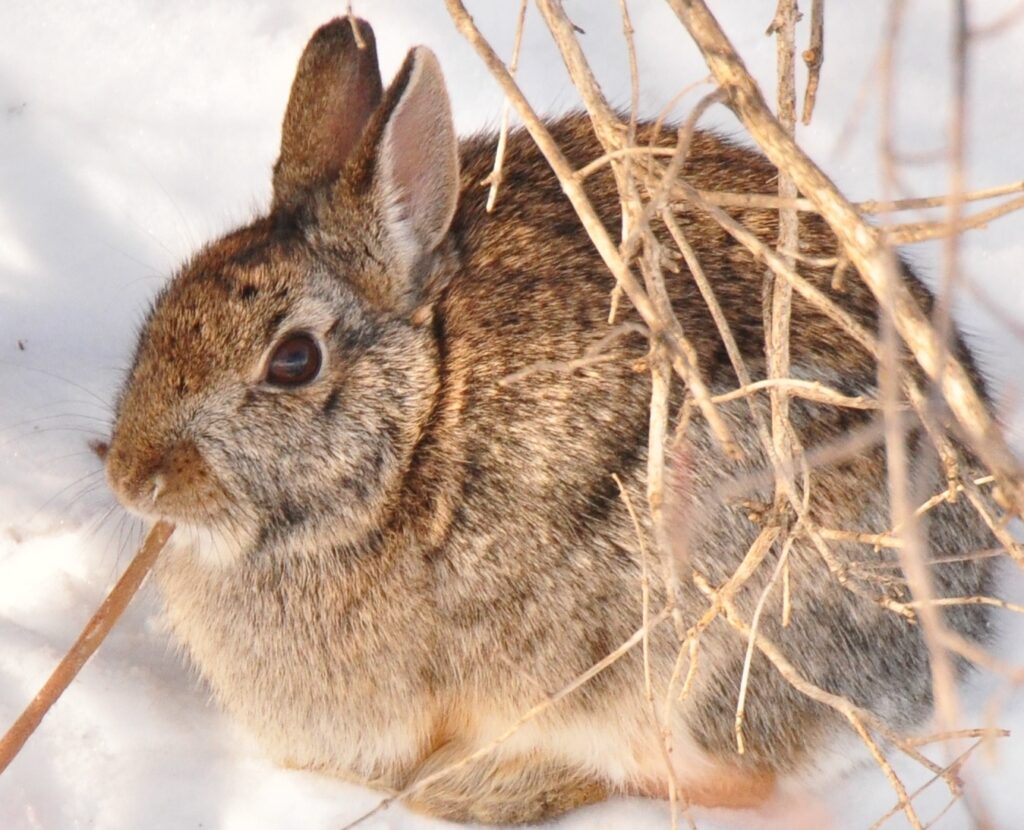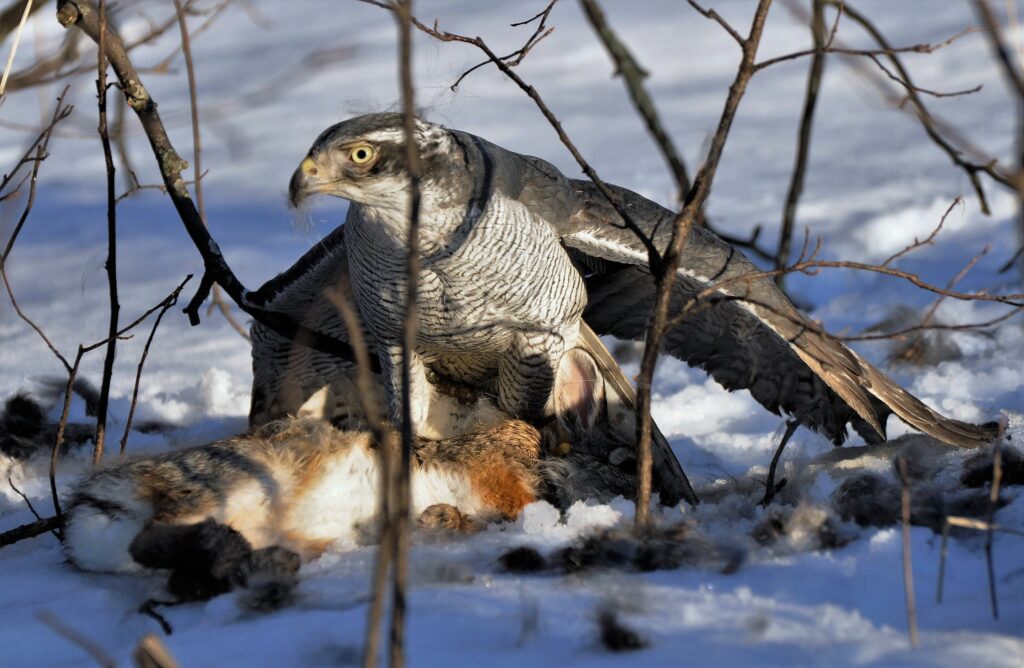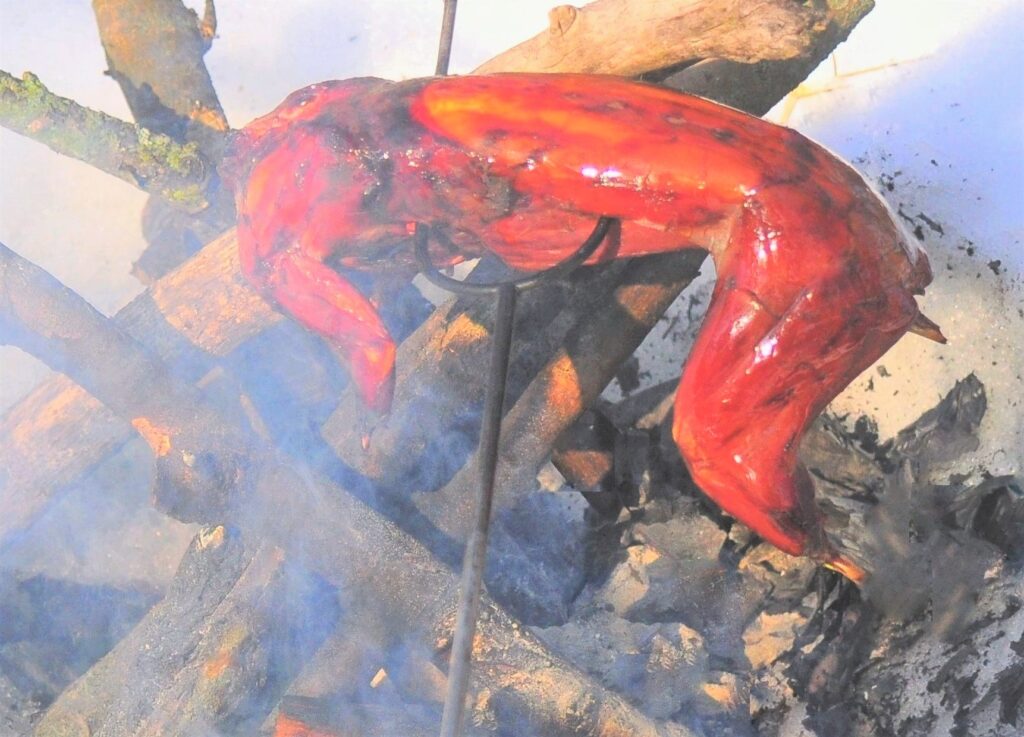Photography courtesy of Lowell Washburn, all rights reserved.
While most Iowa hunting seasons are now closed, cottontail rabbits provide an exception. They remain legal game until the end of February. As abundant as they are nutritious; the daily bag limit is a liberal ten rabbits per day. Rabbit is a winter staple at our home, and there are many excellent heart healthy recipes. Most are quick and easy. Some are a bit more complicated. One represents the ultimate cooking challenge. That recipe is open fire roasting. Master this one and you can cook anything.

Why bother? Well, apart from the culinary challenges, cooking your wild game in the field will definitely give new meaning to the word “freshness”. It also extends your time in the winter woodland which is always a good thing. Here are some basic tips for preparing your own fire roasted cottontail.

Fire Roasted Cottontail
“You cook good rabbit, Pilgrim.” We’re all familiar with that famous movie line spoken by mountain man Bear Claw Chris Lapp in the big screen classic Jerimiah Johnson. Simmering over an open-air fire, Johnson’s rabbit had apparently been cooked to absolute perfection.
The harsh reality is that, when it comes to open fire cooking, “good rabbit” doesn’t come easy. Instead, it can seem near impossible and represents one of the outdoors’s greatest challenges. The list of uncertainties is staggering. No two days offer identical conditions. Outdoor temperature, humidity, fuel quality, and wind speeds will all do their best to trip you up.
I prefer to begin cooking with chilled meat. Once a fresh rabbit is skinned, covering the carcass with a few inches of snow will cool the meat in minutes. Whole rabbits can either be attached to a spit running the length of the carcass, or they can be skewered crossways. Once the fire is going, you have two cooking methods to choose from – direct heat or indirect heat. Although both methods can stand alone, you can also combine the two. Once the fire is lit and initial flames are crackling, place carcass about a foot and a half or more to the side and rotate every three or four minutes.
Once the fire is reduced to coals, I move the rabbit to a place directly above the greatest heat. Depending on those many variables, the meat be as close as 4 or 5 inches to as much as 8 or 9 inches above the coals. The front half of a rabbit will cook about three times faster than the thicker loin [backstrap] and rear legs. Although I’ve never succeeded in having an open pit rabbit cook evenly from front to back – you can come close by keeping the front quarters directed toward the lowest point of heat.

Utilizing high quality cooking fuel is key to success. Although hickory and apple are my favorites, any type of seasoned wood will do the job. Even if you can get it burning, green wood will invariably produce a dark ‘greasy’ smoke that imparts a bitter flavor to everything you cook – avoid green wood at all costs.
Cottontails have extremely lean, light-colored meat. When cooked in open air, they are easy to dry out. Dehydration can be largely avoided by frequently basting the rabbit with olive oil or butter. Seasoning can be as mild, or as spicy, as you prefer. Durkee’s Six Pepper is an excellent, ‘in-between’ seasoning that greatly enhances the flavor of light meats but won’t melt your fillings.
“Cooking times may vary” – I don’t who coined that time worn adage, but it could have been someone attempting to cook rabbit over an open fire. Stack the wood high and put meat close to the coals, and a cold weather cottontail can be done in as little as 30 to 40 minutes — maybe. A slower, more indirect approach may require 1 ½ hours or more of open-air roasting. Regardless of cooking method and seasonings, expect your finished product to take on a pleasant, slightly smoky flavor. The meat of a perfectly roasted rabbit will be pink at the hind leg’s ball joint while remaining moist and juicy all the way through the thickest parts of the legs and backstrap.
There is no denying that open fire cooking represents a steep climb but, with practice, the difficulties can be overcome. Get it right, and you’ve mastered one of the outdoors’s greatest challenges. The sweetest words an outdoor cook will ever hear is when someone across the fire looks up and says, “You cook good rabbit, Pilgrim.”

 Tom Cope
Tom Cope Sue Wilkinson
Sue Wilkinson Susan Judkins Josten
Susan Judkins Josten Rudi Roeslein
Rudi Roeslein Elyssa McFarland
Elyssa McFarland Mark Langgin
Mark Langgin Adam Janke
Adam Janke Joe Henry
Joe Henry Kristin Ashenbrenner
Kristin Ashenbrenner Joe Wilkinson
Joe Wilkinson Dr. Tammy Mildenstein
Dr. Tammy Mildenstein Sean McMahon
Sean McMahon